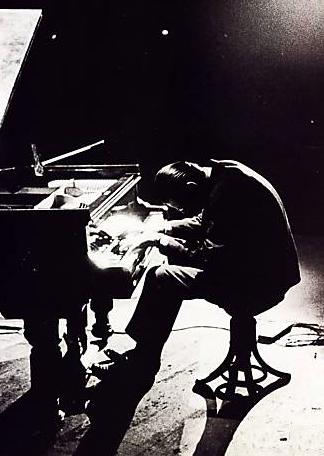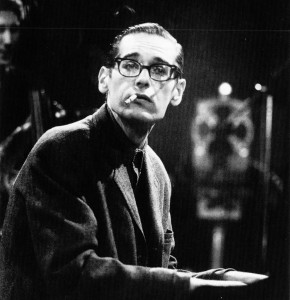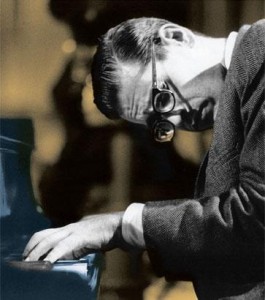Bill Evans, ‘Easy to Love’, 1962 (solo)
In SoTW 060, I talked about one of the very finest pieces of music I know, the 1961 live performance of Bill Evans’ first trio, “Live at the Village Vanguard”, with Scottie LaFaro on bass and Paul Motian on drums. I wrote there that ‘this is as beautiful as music gets, and no words can rival that’. This album is also widely acknowledged as being the touchstone of the modern piano trio. The recording was made on June 25, 1961. Ten days later, on July 5, LaFaro ran his car into a tree and was killed instantly.
Bill’s Elegy to Scott LaFaro

Bill and Scottie hadn’t been buddies. LaFaro harped at Evans frequently to give up his voracious heroin habit, to no avail. But LaFaro’s death had a debilitating effect on Evans. He lost interest in playing for half a year. Evans: “Musically everything seemed to stop. I didn’t even play at home.” His only recording sessions were unenthusiastic efforts, done only to earn a few bucks to support his habit. Bill’s brother remembers him wandering around NYC wearing some of LaFaro’s clothes. It was a bleak time.
On April 4, 1962, Evans made his first attempt to record a solo album. He recorded four cuts and aborted the session. The recordings were shelved until they were released in 1981 without fanfare on a posthumous hodgepodge album of outtakes, “Conception”; and then later tacked on to a 1963 trio set on the album “Time Remembered”.
The four cuts–the Irish standard ‘Danny Boy‘; a Dave Brubeck original ‘In Your Own Sweet Way‘; and two standards, ‘Easy to Love‘ and ‘Like Someone in Love‘, have been considered Evans eulogy to Scott LaFaro. They’re uneven, unfinished, unpolished. But they are performances in which the man’s soul is speaking directly. Without mediation, without technical obstacles. Evans, his pain, and the music. Evans’ liner notes to his first official solo album, “Alone”, 1968:
I have always preferred playing without an audience
Perhaps the hours of greatest pleasure in my life have come about as a result of the capacity of the piano to be in itself a complete expressive musical medium. In retrospect, I think that these countless hours of aloneness with music unified the directive energy of my life. At those times when I have achieved this sense of oneness while playing alone, the many technical or analytic aspects of the music happened of themselves with positive Tightness which always served to remind me that to understand music most profoundly one only has to be listening well. Perhaps it is a peculiarity of mine that despite the fact that I am a professional performer, it is true that I have always preferred playing without an audience. This has nothing to do with my desire to communicate or not, but rather I think just a problem of personal self-consciousness which had to be conquered through discipline and concentration. Yet, to know one is truly alone with one’s instrument and music has always been an attractive and conducive situation for me to find my best playing level. Therefore, what I desired to present in a solo piano recording was especially this unique feeling.
Bill Evans and all the other solo pianists
When I wrote about Brad Mehldau’s very fine solo album, “Live in Marciac” I discussed how differently he performs as a soloist versus his usual trio setting. I also expressed the opinion that I admire his solo works more, across the board. Could it be that I’m saying I like solo piano jazz?
Bill Evans towers over the last 50 years of jazz piano. He recorded from 1960 till his death in 1980. Three major jazz pianists emerged in the decades that followed, all immeasurably influenced by him – Herbie Hancock, Chick Corea and especially Keith Jarrett. And the three of them still exert a great influence over the newer generation of jazz pianists, Brad Mehldau being by far the leader of the pack. The musical affinity between Granddaddy Bill, Pa Keith and Li’l Brad is unmistakable.
I know it’s not fair to compare musicians, but I spend most of my waking hours doing so. And these three do encourage the comparison–all of them frequently play tunes ostensibly unsuited to quiet, introspective solo piano, usually medium tempo, light love song Standards. It’s a practice Bill Evans started, I believe. The bottom line is that I listen to Bill Evans four or five times as much as I listen to Brad, and to Jarrett hardly at all. I’d like to demonstrate why.
Bill Evans, ‘Danny Boy‘, 1962 (solo):
Here’s Bill Evans’ version of ‘Danny Boy’ from that aborted 1962 solo session. And here’s Keith Jarrett solo from 2002, clearly echoing Evans’ treatment. You listen and tell me which of the two men does a respectable, lovely job, and which is expressing a world view of pain, profound insight and gravitas. That, ladies and gentlemen, is why I prefer to listen to Bill Evans playing with one arm tied behind his back (or paralyzed by the needle) to Jarrett at the top of his game.
And here’s Brad Mehldau doing ‘My Favorite Things‘ solo. I find it very admirable. But why do I feel that, in comparison to Bill Evans, I’m watching a kid? Mehldau was 41 at the time of this recording, 10 years older than Evans was in his 1962 solo recordings.
I find Keith Jarrett to be a competent but rather superficial jazz pianist, not a drop more. And Brad Mehldau isn’t Bill Evans. That’s okay. No one is. Well, enough with the comparisons. We haven’t come to bury Keith Jarrett or to minimize Brad Mehldau, but to praise Bill Evans.
The Four 1962 Solo Cuts
Bill Evans, ‘In Your Own Sweet Way‘, 1962 (solo):
Here’s Dave Brubeck’s original (live) ‘In Your Own Sweet Way‘. A lovely tune, indeed. Here’s Miles’ especially lovely treatment of it with his first quintet (and as discussed in SoTW 041). Here’s a rare video of Bill playing the tune with his second trio!
And then there’s Bill Evans playing his pain alone in a studio at night, mourning Scott LaFaro.
Bill Evans, ‘Like Someone in Love‘, 1962 (solo):
‘Like Someone in Love’ was written by Jimmy Van Heusen and Johnny Burke, a sweet piece recorded by Dinah Shore in 1944. Here’s Ella’s lovely version. And here’s Bill Evans taking a bit of fluff, and investing it with the weight of the weary world.
Bill Evans, ‘Easy to Love’, 1962 (solo):
And then there’s our favorite of the four, a Cole Porter gem, ‘Easy to Love‘. Here’s the original, sung by James Stewart(!!!) in the 1936 movie, “Born to Dance”. And for comparison, here’s Ella’s definitive classic treatment. Tender, tasteful, loving, right? Here’s a lightweight version by Billie Holiday, no stranger to pain herself.
And then Bill Evans plays it. And he takes you to dark, harrowing places. I listen to this, my kishkes squinch up. Life as a lemon, his deftness only emphasizing the wrenching beauty of the exquisite pain he’s playing. He speaks with the voice of a musician using his art to describe the world as he has viewed it. A man who has experienced all the pain in the world. A man who has a lot to say. An artist who can inform you. What I call life-changing music.
More Bill Evans Solo
Over the rest of his career, Evans recorded solo infrequently. Two examples are well-known among Evans aficionados. On his very first album, in 1959, he recorded Leonard Bernstein’s ‘Some Other Time‘. At one point, he began improvising on the introduction to the song, and the result was his legendary ‘Peace Piece’. In 1963 he recorded “Conversations With Myself“, an album of overdubbed piano tracks (using Glenn Gould’s piano!), winning him the Grammy award for Best Jazz Instrumental Album, Individual or Group. There was some discussion as to whether it should be considered a solo or group recording. In 1966, three days after his father died, Evans recorded a 4-part medley, ‘In Memory of his Father‘. There are also two albums he released in 1968 (“Alone”) and 1975 (“Alone Again”). They’re fine, even moving on occasion; but typically of his middle years, not Evans at his best.
There’s an obscure European CD entitled “Bill Evans Solo at Carnegie Hall 1973-1978”, which includes two short sets. The music is fascinating for us obsessives but non-essential for normal folks.
Bill Evans at Carnegie Hall, solo 1973, ‘I Loves You, Porgy‘
Bill Evans at Carnegie Hall, solo 1978, ‘You Must Believe in Spring‘
With his last trio (1979-80), Evans frequently recorded ‘Nardis’ with an extended solo piano introduction, but the style there is muscular and energetic, a whole different ballgame. Here’s a whole long SoTW on the evolution of Bill’s treatments of ‘Nardis’ over the decades.
Eight months after the four solo pieces discussed above, Evans recorded 13 cuts alone in the studio at night (April 1963) which were only released in 1984 and then later as “The Solo Sessions V.1 and V. 2,” “some of the most private and emotionally naked music I have ever heard” (Martin Williams, “Complete Riverside Recordings” liner notes). These are some of Evans most moving recordings, the fruition of the ragged 1962 recordings.
‘What Kind of Fool Am I?“, ‘Everything Happens to Me‘
If you are as taken by them as I am, dig up the 1963 sessions. They’re moving, profound, unforgettable, works that make listening to music the best part of my life. As always, Bill says it best: Perhaps the hours of greatest pleasure in my life have come about as a result of the capacity of the piano to be in itself a complete expressive musical medium.
If you enjoyed this post, you may also like:
041: Miles Davis, ‘It Never Entered My Mind’
060: The Bill Evans Trio, ‘Gloria’s Step’ from “Live at The Village Vanguard”
079: Miles Davis, ‘So What’ (“Kind of Blue”)









What great music to sooth my soul. I see you are nearing the century mark for your posts. Thanks and keep up the great work.
Oh, and someone forgot to teach Bill Evans good posture. His playing position is even difficult just to look at.
Danny Boy is absolutely Celestial. Thanks for taking the time trying to reason with the emotions one can experience while listening to these recordings (successfully one might add). Personally it has been one of the very few recordings that can make me cry & go straight into the nerve system to hit the deepest emotions a 6 foot 3, 200 pound guy like me can have.
The more I hear him the more obvious it becomes that his genius was the product of endless hours of hard work, devotion to his craft and a willingness to spend “countless hours of aloneness with music.” He was obsessed with sharing what he heard and his message was “to understand music most profoundly, one only has to listen well.” He struggled to reach the depths and emerged with the most priceless pearl.
Thank you for re-posting his “Easy to Love” to mark the anniversary of his passing.
Wow Jeff!
What a great post. This will keep me listening for a week or more. So much wonderful music.
Your accompanying text has given me a host of different ideas and previously unrealised reasons why I have always loved Bill’s work.
I’m of an age that enabled me to see Bill play live several times and I’,, never forget those experiences.
Whenever I feel I’m forgetting his absolute genius, I stick on my video of ‘The universal mind of Bill Evans’ and renew my spiritual connection.
You can’t believe the magic that comes from his fingers (I visualise ET’s sparking finger from the advertising) and just begin to understand where he is coming from musically.
“Sometimes all I want is to be alone and listen to Bill Evans.” I read this somewhere recently, can’t recall where. I haven’t endulged myself but it sure makes perfect sense. He has a way of cutting through the crap and exposing the most raw of emotions, always beautifully.
Thank you for sharing him again.